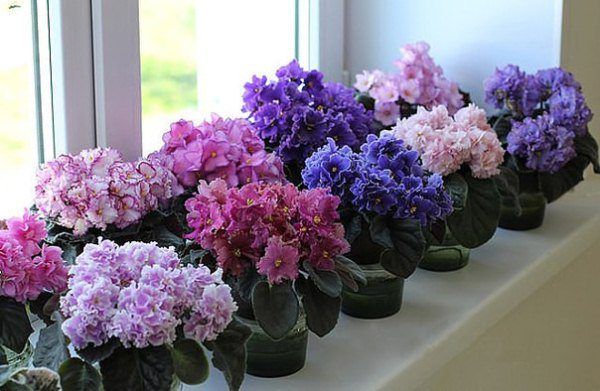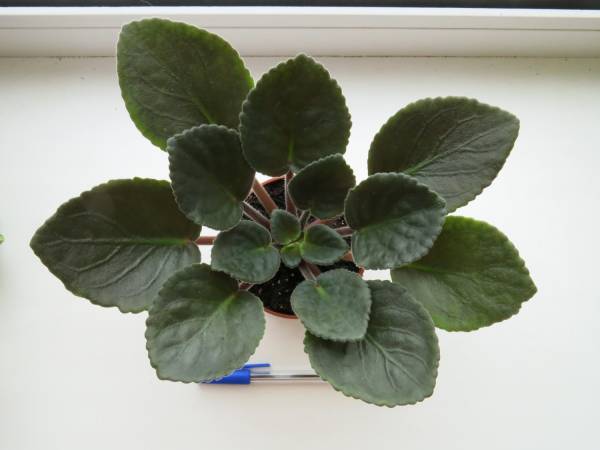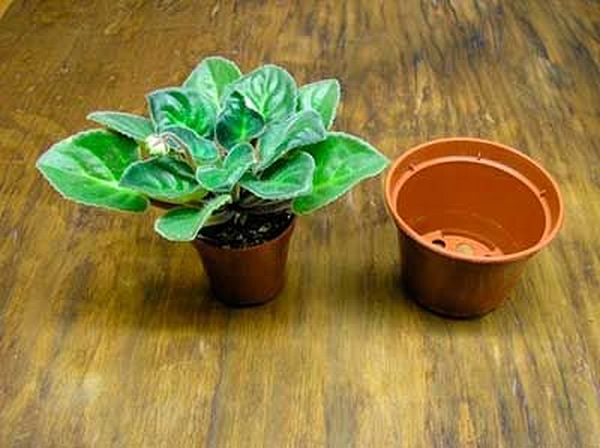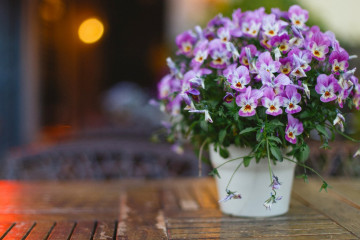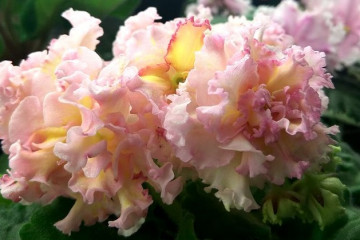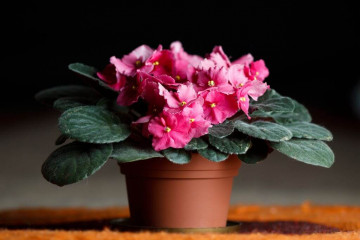Description of the variety of the flower violet duchess deluxe
Content:
Today there are more than 20 types of violets. Each has its own characteristics. One of these species is the Duchess violet and the Duchess Lux violet hybrid derived from it, which has insignificant differences.
Appearance, description of the variety
Violet Duchess is characterized by a striking appearance. Most often, the plant has lilac or purple buds.
Leaves
The leaves of these violets are large in size and have a rounded heart-shaped shape. There are small villi on the surface of the foliage, which makes them appear terry. Due to the medium size of the leaves of the RS-Duchess violet, the buds themselves look massive.
Flowers
During the flowering of Saintpaulia, the Duchess gathers in a bunch of 4-5 beautiful large buds over the leaves. The size of flowers reaches 8 cm. Flowers, like leaves, are covered with short thin villi.
The main color scheme of the buds is dark purple (violet), which flows into white at the edges. The middle of the flowers of these violets is usually yellow.
Family and history of appearance
The plant belongs to the Gesneriev family.
Violets RS-Duchess were bred in 2001. The plant owes its origin to the breeder Svetlana Repkina. The abbreviation RS before the name is an abbreviation of the name and surname of their creator.
Features of caring for a violet Duchess at home
At home, the flower needs to create suitable conditions. They are made up of several factors.
Temperature
To grow an adult plant, an air temperature of +20 to +23 ° C is required. Young violets require more heat, they are recommended to be grown at temperatures from +23 to +26 ° C.
Lighting
Violets are very fond of light, but they feel bad in direct sunlight. The best place for this plant may be the windowsill in the eastern part of the house. If there is none, you can equip a part of the window for the flower, where there is the least amount of light.
Watering
For watering plants, use settled tap water at room temperature. Water the violet in such a way as to avoid the accumulation of water next to shoots and leaves. The soil must be kept moist, it can dry out only by a third, since otherwise the leaves will begin to dry out and fall off.
Spraying
Violets do not like spraying. If, nevertheless, the flower is dusty, you should use water at room temperature and carefully wash off the dust, and then blot everything with a napkin.
Humidity
The plant should never be placed in rooms with high humidity. If moisture gets on the stems and leaves of a delicate flower, it will die. It is better to place it in a place with a dry microclimate.
Priming
Due to the complex nature of the plant, you need to choose the soil carefully, otherwise the flower will get sick and even die.Like all houseplants, violets prefer soft soil, in which there is no obstruction of oxygen to the roots.
The main features to keep in mind when choosing a soil:
- The soil should be chosen saturated with trace elements.
- Nothing was supposed to grow in this soil for a year.
- Before planting, you should feed the land, for this it is better to use phosphorus and potassium. After that it should be fertilized regularly.
- An excellent option would be soil from the forest.
Top dressing
You need to feed the violet twice a month throughout the year. After the transplant, take a break for 4-6 weeks. You can use mineral fertilizers for flowering plants.
All year round, the violet requires feeding, which is carried out twice a month. A break of 4 to 6 weeks is needed only after the transplant. For feeding, you can use a mineral complex that is fertilized with flowering plants.
When and how it blooms
The plant has five plum-white petals. The flower usually has 5-6 clusters that form a beautiful bouquet. The flowers themselves, like violet foliage, are covered with small villi, so they seem terry to the touch.
Flower shapes
Violet buds resemble a ball in shape and can remain in this shape for a very long time. When the bud opens, it visually resembles a rose flower.
Flowering period
You can enjoy the beauty of violet flowers from September to March. After the flowering of the plant, a small seed capsule is formed.
Changes in care during flowering
At hotter temperatures, the plant has solid, bright flowers, and when the temperature drops, a white color is added. In order for the Duchess to fully show her color scheme, it is recommended to place it on the lower shelves of shelves or cool window sills during the flowering period. Despite the flower's love for light, it should not be placed in direct sunlight, as this leads to yellowing of the leaves and withering of the buds. You can understand that there is too much light by the thickening of the center and short peduncles, which are difficult to break through. The plant needs a lot of free space, and in cramped conditions, the leaves take a more vertical position.
In order for a beautiful rosette to form and the flowers are lush, the violet needs a long daylight hours, correctly selected pot and soil, regulated watering and periodic feeding. With regard to temperature and humidity, they are of secondary importance in the care. Despite the fact that the plant does not tolerate heat well, this is compensated by good ventilation of the room.
Reproduction
Several methods have been invented for breeding violets at home.
Germinating seeds
It will not work to get a full-fledged strong plant by seed. To get seedlings, special conditions are needed for their growth.
Rooting cuttings
The vegetative method is also suitable for plant propagation. To grow violets by rooting cuttings, you need to choose a healthy leaf and cut it obliquely on the petiole, leaving about 3-5 cm.It is best to root in boiled water. However, it is also possible in the ground. It should be moist and loose.
The stalks should be placed to a depth of no more than 2 cm. Cover the seedling with foil, regularly ventilating and moisturizing the soil. The pot must be placed in a warm place (with a temperature not lower than +20 ° C), where there is diffused light. The rooting period ranges from 4 to 6 weeks.
Flower propagation
With the help of a flower, you can grow yourself another violet. To do this, you need to cut off the flower along with the leaf under it. Then place it in the rooting machine and cover with oilcloth.
Transplant after purchase and during reproduction
Do not disturb the violet once again. She does not need frequent transplants. It is needed only in case of plant disease, then it is imperative to move it to a new soil. The transplant is carried out once or twice a year. It is best to do this in the fall or spring. The most acceptable option for transplanting a flower is transshipment.
Possible problems in growing violets RS-Duchess
Violets, like other houseplants, sometimes get sick. Each problem has its own solution, the main thing is to establish the exact cause.
Leaf problems
These violets also suffer from fungal diseases. With excessive moisture, the blow falls primarily on the roots and leaves. If this happens, you should first apply a fungicide. In addition to the fungus, plants are susceptible to powdery mildew, as well as gray rot or fusarium. This can happen due to low temperatures, moisture on foliage, or drafts.
Pests
The mite is the most dangerous pest for violets. You can find it by drooping and withering leaves. In this case, it is almost impossible to cure the plants. There is only one way: spray with a special anti-tick agent.
In addition, the violet can become infected with worms or aphids. During the flowering period, there is a risk of damage by root gall nematode. This disease is accompanied by growths on the roots - galls, in which the development and reproduction of worms takes place.
Diseases
A violet, like any plant, can easily get sick from another flower nearby. You can bring the disease with dirty hands if you touch violet leaves with them. Pets, too, often carry many diseases on their fur. Most often, the plant is sick in May and September.
Due to dampness, low temperature or stagnant water in the pot, brown or gray spots may appear on the leaves or flowers - fungus. Signs of a fungal infection can be a moldy smell on the flower or the softness of the shoot itself. If they are found, you should immediately remove the damaged areas, then start replacing the soil, and before transplanting, treat everything with a fungicide.
Signs of improper care
One of the signs of improper care is the appearance of gray rot when water gets on the leaves. The affected leaves must be removed. If you water the plant with cold water, there is a risk of brown spots. In case of physical injury, a sharp drop in temperature, a draft or dry air, the leaves dry out. The same problem can be encountered if you overdo it with fertilizers or if there is not enough light.
Thus, like any violet, the RS-Duchess requires careful care and attention. When handled correctly, it will delight with bright colors and exquisite beauty of the leaves. The Duchess is suitable for experienced florists, but beginners are not recommended to start her.
